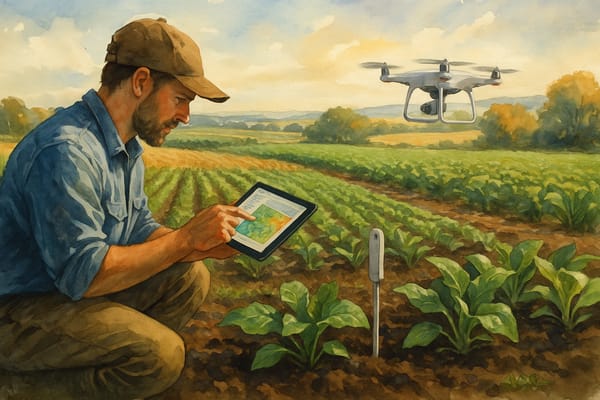Hidden Intelligence Beneath Our Feet
Cornwall’s landscape is complex. Beneath its rolling fields, ragged hedgebanks, and coastal pastures lie layers of soil shaped by centuries of farming, mining, weather, and time. In one patch, heavy clay stifles roots. In the next, sand lets moisture slip through in a matter of hours. For generations, farmers have relied on instinct to manage these inconsistencies. Today, a new form of intelligence is lending a hand.
Digital soil mapping, artificial intelligence, satellite imaging, drones, and mobile apps are transforming how we understand, monitor, and care for the land. From predicting nutrient needs to spotting water stress before it’s visible, these tools are giving growers in Cornwall—and across the UK—something precious: foresight.
What the Technology Looks Like in 2025
Across the country and here in Cornwall, several types of digital soil technologies are now being trialled or adopted. Each addresses a different challenge, but all aim to help landowners make more precise, cost-effective, and environmentally responsible decisions.
1. Soil Mapping with AI
Modern soil probes now capture data on pH, organic matter, texture, compaction, and even residual contaminants. AI models process this sensor data—alongside satellite imagery, topography, and field history, to generate high-resolution digital soil maps. These maps allow for targeted lime or compost application, rather than blanket treatment, which reduces input costs and improves soil health.
In Cornwall, where fields often vary widely in fertility or structure due to historical use and weathering, this kind of site-specific insight is invaluable.
2. Mobile-Based Soil Diagnostics
New smartphone apps and low-cost kits are making sophisticated soil analysis accessible to all. Using a phone camera, colour strips, or small infrared lenses, these tools estimate moisture, nutrient content, and organic matter in minutes. Some connect to sensors via Bluetooth. The result: immediate, location-aware advice on what your soil needs.
For Cornwall’s many small family farms, community plots, and remote growers, this represents a leap in autonomy—offering quality guidance without costly lab tests or long wait times.
3. Sensors and Drone Surveillance
Wireless in-field probes now log moisture, temperature, and conductivity around the clock. Drones, equipped with multispectral or hyperspectral cameras, scan fields for early signs of pest outbreaks, disease pressure, erosion, or nutrient deficiency.
When integrated into a single digital platform, these tools offer a kind of “sixth sense” for the landscape—spotting stress days or weeks before it's visible. And on Cornwall’s often unpredictable, slope-prone, or flood-sensitive terrain, such foresight can be the difference between loss and recovery.
4. AI-Powered Decision Making
The true strength of this digital toolkit lies in integration. Data from soil probes, drones, satellites, and local weather models is now processed by AI to deliver real-time recommendations: where to irrigate, when to graze, how much compost to apply, which patches need a rest.
Yield improvements of 12 to 30 percent have been reported in early-adopter systems, especially where farmers combine these tools with responsive, adaptive management.
Why Cornwall? Why Now?
Cornwall’s land is famously varied and often challenging. One field might contain sandy ridges, boggy corners, and compacted gateways within a few metres of each other. Weather swings from torrential rain to dry spells within a season. Legacy issues from historic mining or patchy fertility complicate decisions further.
This is not land that responds well to uniform treatment. It needs nuance. And that’s precisely what these technologies offer.
- Precision Fertiliser Use: Digital maps help ensure lime, compost, or minerals are applied only where needed—reducing waste, saving cost, and preventing nutrient run-off into sensitive watercourses.
- Improved Water Management: Sensors warn of waterlogging or drought before symptoms appear, guiding irrigation and grazing decisions in a timely way.
- Climate Resilience: Soil carbon monitoring supports regenerative goals and eco-scheme compliance. AI modelling helps farmers plan rotations and cover crops that protect vulnerable soils from erosion and nutrient loss.
Limitations, Literacy, and Ground Truths
This revolution isn’t without its challenges. Technologies perform best when paired with digital confidence and clear local insight. Calibration errors, data gaps, or over-reliance on algorithmic recommendations can lead to mistakes—particularly on patchy or marginal ground.
Just as important as the tech itself is the human understanding behind it. The greatest success stories come not from automation alone, but from growers who use these tools as partners, not replacements, for their own wisdom. Ground-truthing and checking what the data says against what the land tells you is essential.
And for the technologies to thrive, digital literacy must be nurtured. That means support for learning, equitable access to devices, and practical training so that these tools become empowering, not intimidating.
A New Lens on the Landscape
It’s tempting to see soil as static. But in Cornwall, where every field has its quirks and every season tells a different story, the truth is far more dynamic. AI, sensors, and digital platforms don’t just offer efficiency. They offer a new way of seeing—a kind of landscape literacy that blends science, place, and care.
Yet the usefulness of these tools depends on more than code and signal. Their real value emerges when paired with lived experience and local knowledge. Soil sensors mean little without someone to interpret their meaning. Drone maps need walking. Data needs ground-truthing. And like all technologies, these tools work best when digital literacy is fostered, and when farmers feel empowered, not overwhelmed.
In the hands of Cornish growers, these technologies are not simply upgrades. They’re part of a wider cultural shift—where insight deepens intuition, and even the most ancient soils are read with new clarity, one season, one decision, one field at a time.








